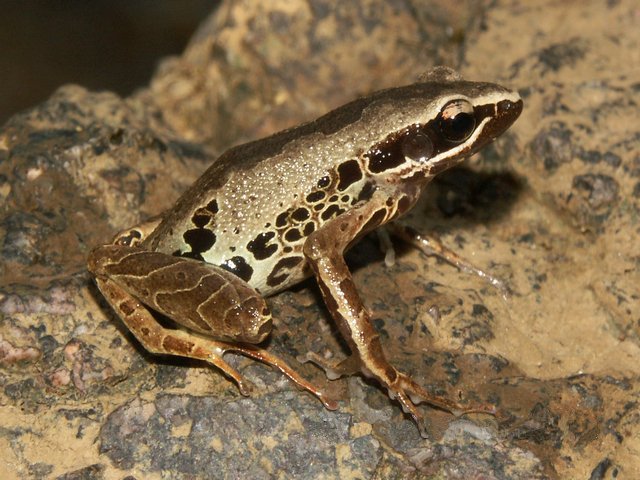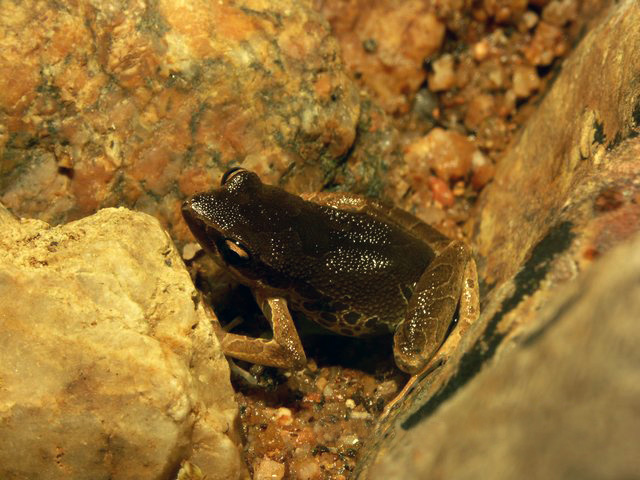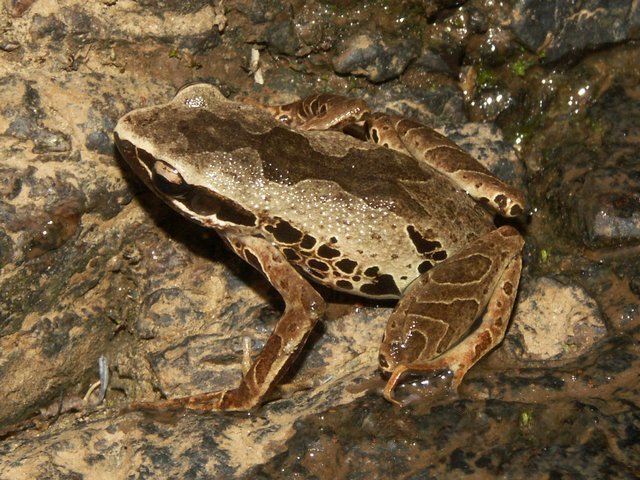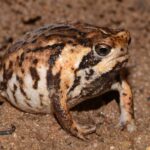- Discovering Cardioglossa Leucomystax: The Enchanting Silver-Spotted Long-Fingered Frog
Discovering Cardioglossa Leucomystax: The Enchanting Silver-Spotted Long-Fingered Frog#
Deep within the lush forests of Central Africa, beneath the shadowed cover of towering trees and among moisture-soaked foliage, a tiny marvel quietly thrives—Cardioglossa leucomystax, the silver-spotted long-fingered frog. Often overlooked due to its small size and elusive habits, this striking creature subtly contributes to the intricate tapestry of rainforest biodiversity. With vivid coloration, distinctive physical adaptations, and fascinating behavioral traits, Cardioglossa leucomystax is perhaps one of nature’s hidden wonders; though small and secretive, this frog species embodies the delicate and complex relationships defining tropical ecosystems.
Belonging to the Arthroleptidae family, Cardioglossa leucomystax derives its scientific name from the Greek “Cardio,” meaning heart, and “glossa,” meaning tongue—aptly highlighting unique anatomical adaptations shared within its genus. With delicate fingers and beautiful patterns across its skin, numerous mysteries and ecological narratives revolve around this small amphibian, making it worthy of deeper exploration and protection.
Taxonomy and Classification#
Cardioglossa leucomystax sits comfortably within the family Arthroleptidae, an intriguing group of slender-limbed frogs primarily found across sub-Saharan Africa. This family is known for incredible species diversity and ecological specialization, particularly within tropical rainforests.
Within the genus Cardioglossa, species exhibit elongated fingers, holographic coloration, and specific reproductive strategies, collectively earning them the charming description “long-fingered frogs.” Each species demonstrates subtle distinctions adapted to its particular niche.
The species name, leucomystax, is particularly evocative, translating as “white moustached.” This refers directly to the eye-catching white patches that set apart individuals of this species from their darker forest surroundings and even from its close relatives such as Cardioglossa melanogaster or C. pulchra, with slightly differing colorations and patterns found within overlapping ranges.
Natural Habitat#
Cardioglossa leucomystax demonstrates strong habitat fidelity and can be typically found within a relatively restricted region encompassing areas such as Cameroon, Equatorial Guinea, Gabon, and Republic of Congo. It flourishes primarily in moist montane and lowland forests, often nestled amid dense leaf litter, moss-covered roots, and shallow stream banks, picturesque micro-environments characteristic of verdant Central African landscapes.
In these humid environs, the frog frequently takes refuge beneath fallen leaves or surrounded by richly textured moss—a microhabitat offering optimal moisture retention and protection against predators. This highly specific habitat preference makes the species sensitive to environmental disruptions, positioning it as something of an ecological sentinel; noticeable declines in local populations can often serve as clear indicators of habitat degradation and climate-driven changes.
Please imagine for a moment the species’ natural home—lush ferns unfurl beneath dappled sunlight, trickling streams flow gently through dense vegetation, providing a soothing soundtrack to the forest’s vibrant symphony. Carefully concealed among moist leaf litter, the silver-spotted long-fingered frog watches patiently, well-adapted and perfectly at home.
Physical Characteristics#
The visual appearance of Cardioglossa leucomystax is nothing short of stunning, despite its miniature stature. Adult frogs typically measure around 25 to 30 mm, placing them among the smaller members of the amphibian community. Yet, what they lack in size, they compensate for with breathtaking beauty and unique morphological adaptations inspired by evolutionary pressures.
The species displays exceptionally sophisticated coloration: subtle browns and grays along its dorsal surface blend seamlessly with surrounding wet leaves and bark, punctuated with intricate spots and patterns. The standout characteristic—and the inspiration behind the species’ charming name—is the dazzling pair of white or silver patches located just beneath its eyes. These “white moustaches,” delicate features fading subtly into surrounding skin pigments, lend it a lovable and easily recognizable profile.
Adding to its intriguing appearance are its remarkably elongated fingers, which provide it unparalleled dexterity when navigating slippery vegetation and leaf-covered substrates. These nimble digits enhance its agility, allow efficient climbing, and promote precise, agile movements necessary for capturing elusive prey.
Behavior and Life Cycle#
Secretive Hunting and Feeding Strategies#
As an insectivore, Cardioglossa leucomystax hunts predominantly at night, taking advantage of twilight conditions and humid temperatures conducive to heightened insect activity. Guided by sharp eyesight and sensitive vibration receptors, it ambushes unsuspecting prey including ants, termites, spiders, and a variety of small arthropods—thus playing a subtle but critical role in pest regulation within its rainforest habitat.
This nocturnal behavior, combined with cautious, cryptic tactics, allows the frog to successfully avoid predation, an essential adaptation given its small size and lack of noteworthy defensive measures such as toxins or formidable physical deterrents.
Reproduction and Life Cycle#
Observations of Cardioglossa leucomystax’s reproductive biology reveal intriguing details. As breeding season approaches—usually in response to increased rainfall—males become more vocal, gathering in humid locations to court females through gentle yet melodious calls. These soft vocalizations help females locate potential mates within the dense, acoustically challenging forest landscape.
Once paired, the female deposits relatively small clutches of gelatinous eggs along damp vegetation close to shallow streams or temporary forest pools. This strategic placement ensures optimal temperature regulation and higher survival probabilities for the eggs. The tadpoles, uniquely adapted to fast-developing forest environments, display efficient growth, rapidly transitioning into miniature copies of adults within weeks, minimizing vulnerability to predation and environmental factors.
Ecological Role#
Though small and often unnoticed, Cardioglossa leucomystax plays an instrumental role within its ecological niche. As a predator, the species regulates insect populations, consequently influencing local biodiversity balance. Simultaneously, as prey for larger amphibians, reptiles, birds, and mammals, this species contributes to maintaining equilibrium and intricate food web connectivity throughout the ecosystem.
Furthermore, amphibians—including this silver-spotted marvel—act as vital indicators of environmental health. With their permeable skins, Cardioglossa leucomystax and its kin demonstrate acute sensitivity to environmental pollutants and climate changes—serving effectively as ecological sentinels alerting scientists and conservationists to emerging threats within forest ecosystems.
Threats and Conservation Status#
Current Threats Facing This Fragmented Creature#
Like many species in the tropical amphibian community, Cardioglossa leucomystax faces increasing vulnerability as humans exert pressure on vital habitats. Widespread deforestation compounded by agricultural expansion, logging activities, and infrastructure development remains primary threats, resulting in habitat fragmentation, reduction, and isolation of viable population segments.
Additionally concerning are shifting climate patterns affecting rainfall variability and seasonal moisture-dependent breeding elaborations, potentially disturbing carefully synchronized reproduction efforts previously fine-tuned by natural selection across generations. Amphibian diseases, notably chytridiomycosis caused by the fungus Batrachochytrium dendrobatidis, represent an emerging threat to this species’ stability, warranting ongoing monitoring and research.
IUCN Status and Conservation efforts#
Currently listed as Least Concern by the International Union for Conservation of Nature (IUCN), Cardioglossa leucomystax maintains comparatively stable population levels. Yet this designation should not breed complacency; proactive conservation measures such as habitat preservation, ecosystem monitoring, and environmental education initiatives remain crucial priorities to safeguard sustained survival.
Cultural and Scientific Significance#
Though the small silver-spotted frog may not hold widespread cultural symbolism, its intrinsic value as an integral component of the rainforest ecosystem grants it substantial ecological significance. To researchers, Cardioglossa leucomystax serves as an accessible model organism valuable for endocrine studies, toxin research, and ecological monitoring programs emphasizing delicate habitat interactions.
Perhaps more valuably, the presence and health of this species symbolize the productivity, integrity, and overall biodiversity value embodied by Central Africa’s rapidly disappearing rainforests— ecosystems critical to global ecological stability and the preservation of planetary biodiversity.
Conclusion: Advocacy and Action for Cardioglossa Leucomystax#
While humble and diminutive, Cardioglossa leucomystax exemplifies the rich biodiversity found in Central Africa’s threatened rainforest habitats, serving as a poignant reminder of our interconnectedness with the natural world. Its continued health echoes our commitment to caring for landscapes vital to maintaining biodiversity everywhere.
Ultimately, by familiarizing ourselves with hidden organisms like Cardioglossa leucomystax, we strengthen our understanding of the diverse biological tapestry around us, igniting deeper appreciation—and action—for ongoing conservation. Protecting such fascinating creatures can begin with simple curiosity, engagement, and advocacy, empowering each person to contribute meaningfully toward safeguarding these remarkable natural treasures.


















